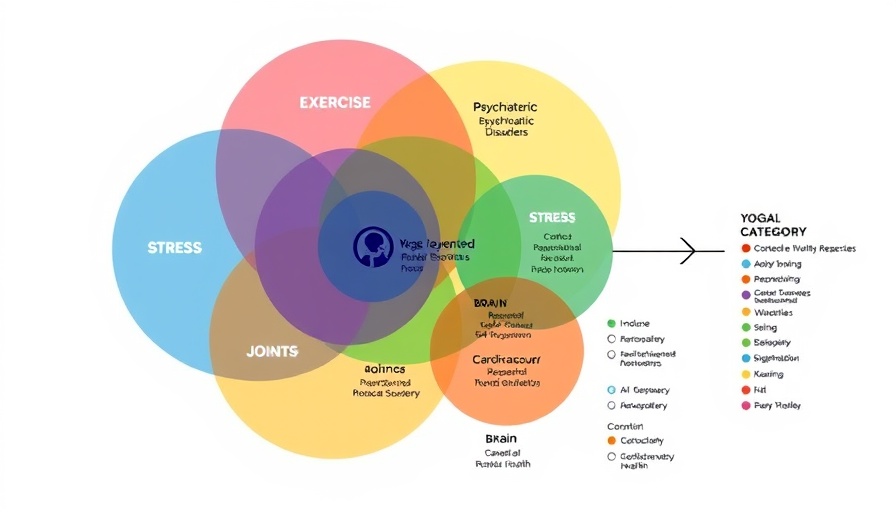
Mapping the Depth of Yoga Research: A New Era
In the ever-evolving world of health and wellness, yoga stands out not just as a practice but as a significant area of scientific inquiry. A recent study has employed advanced artificial intelligence (AI) and text-mining techniques to create a comprehensive map of yoga research, making the vast and intricate literature accessible and intelligible for practitioners, teachers, and students alike.
Unpacking the Study: What Was Analyzed?
This groundbreaking research conducted a thorough analysis of thousands of scientific articles related to yoga, revealing four core themes. The research categorized these themes into: yoga as exercise, its effects on the body and physiology, its psychosocial aspects, and its therapeutic contributions. By utilizing AI, the study highlighted important connections among these areas, illustrating how they relate to one another and showing the broader implications of yoga in scientific discourse.
The Purpose: Bridging Tradition with Modernity
The primary goal of this study was to enhance understanding of how yoga research is structured and to identify both trends and gaps. This endeavor not only informs existing practitioners of yoga but also endeavors to link traditional yoga knowledge with modern scientific advancements. By connecting these dimensions, the researchers aim to guide future research directions that could lead to more effective practice strategies and therapeutic approaches.
AI and Text Mining: Transforming Research
AI and text mining are far from just technological buzzwords; they are revolutionizing the way we digest and understand complex scientific material. In the context of yoga research, these tools shine a light on clusters of research topics, making it easier for other researchers to navigate the sea of existing literature. This innovation is significant, as it supports multidisciplinary collaboration and amplifies our collective understanding of the holistic nature of yoga.
The Impact of Historical Context
The exploration of yoga isn’t just a modern phenomenon; it’s rooted in ancient practices. Historically, yoga has served as a pivotal tool for mental and physical well-being, and the current influx of scientific studies demonstrates a renaissance in its acceptance in the scientific community. This ongoing research validates the wisdom of ancient teachings while opening doors for new interpretations and applications in today's health landscape.
Future Predictions: Expanding Yogic Knowledge
With the emergence of advanced analytical techniques, future yoga research is poised to flourish. As we continue to gather more data on how yoga interacts with various health outcomes—such as stress reduction, improved mental clarity, and enhanced physical fitness—there is tremendous potential to develop tailored yoga interventions that can target specific populations and challenges.
Common Misconceptions Debunked
Many people regard yoga simply as physical exercise, overlooking its expansive benefits. This study aims to dispel such myths, clarifying that yoga encompasses a wide spectrum of practices, theories, and potentials. Understanding the deeper connections in yoga research underscores the transformative power of this ancient practice, making it essential knowledge for anyone involved in health and wellness.
Practical Insights: Strategies for Practitioners
For yoga practitioners, teachers, and students, the study provides actionable insights. Firstly, engaging with these findings allows practitioners to integrate new scientific understandings into their teaching and practice. Secondly, recognizing the interconnectedness of different themes in yoga can encourage an informed approach to personal wellness and community teaching. Lastly, being aware of gaps in research presents opportunities for practitioners to contribute to the evolving knowledge base, filling voids with their own lived experiences and teachings.
The Road Ahead: Connecting Yoga and Research
The intersection of yoga practice and scientific research represents a dynamic field that is growing at an incredible pace. As more individuals come to embrace the wellness aspects of yoga, the accompanying research will continue to unlock new pathways for health and healing, inspiring even deeper engagement with this age-old discipline.
In conclusion, understanding how yoga research connects through innovative mapping techniques not only enhances our appreciation for this practice but also empowers us to make informed decisions about our health. So whether you're a practitioner or a passionate teacher, diving into the research can provide formidable benefits.
Join us in embracing the fusion of yoga and science by delving into this research and incorporating these insights into your practice. Let's continue to explore how yoga can profoundly enrich our lives, supported by evidence-based knowledge!
 Add Row
Add Row  Add
Add 




Write A Comment